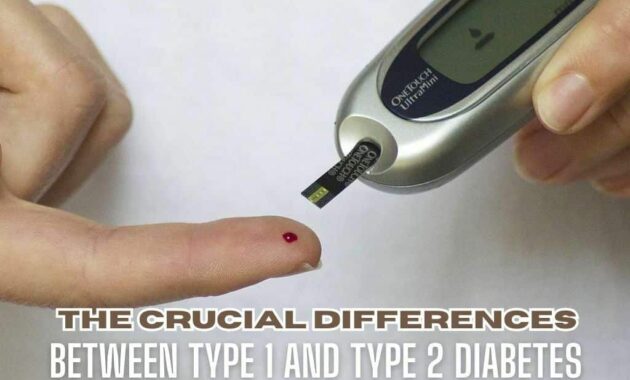If you’re reading this, chances are you or someone you know has been diagnosed with diabetes. It’s a condition that affects millions of people worldwide and can be overwhelming to navigate. But don’t worry, I’m here to break down the differences between type 1 and type 2 diabetes.
What is Diabetes?
Before we dive into the differences between the two types of diabetes, let’s first understand what diabetes is.
Diabetes is a chronic condition that affects the way your body processes blood sugar, also known as glucose. Glucose is a vital source of energy for your body, but it needs insulin, a hormone produced by the pancreas, to be able to use it properly. When your body doesn’t produce enough insulin or can’t use it effectively, the glucose stays in your bloodstream, which can lead to high blood sugar levels.
Why is it Important to Understand the Differences Between Type 1 and Type 2 Diabetes?
While both types of diabetes share some similarities, they are different in terms of their causes, symptoms, treatments, and management. Understanding these differences is crucial for effective management of the condition, as well as prevention of complications that can arise from uncontrolled blood sugar levels. Here are some reasons why it’s important to understand the differences:
a. Correct Diagnosis
A correct diagnosis of the type of diabetes is essential for effective treatment and management of the condition. Misdiagnosis can lead to inappropriate treatments and can worsen the condition.
b. Treatment Options
Treatment options for type 1 and type 2 diabetes are different, and understanding the differences can help you choose the best treatment plan for your condition.
c. Complications
Uncontrolled diabetes can lead to complications such as heart disease, stroke, kidney disease, and nerve damage.
Understanding the differences between type 1 and type 2 diabetes can help you manage your condition and prevent these complications.
Now that we understand the importance of knowing the differences between type 1 and type 2 diabetes, let’s dive into what sets them apart.
Type 1 Diabetes: What You Need to Know
Type 1 diabetes, also known as juvenile diabetes, is a condition in which the immune system attacks and destroys the insulin-producing cells in the pancreas. Without insulin, glucose can’t enter your cells and your blood sugar levels can become dangerously high. Here’s what you need to know about type 1 diabetes:
a. Definition and Causes of Type 1 Diabetes
- Type 1 diabetes is an autoimmune disease where the body’s immune system mistakenly attacks the insulin-producing cells in the pancreas.
- It’s not entirely clear what causes the immune system to attack the pancreas, but genetic and environmental factors may play a role.
b. Symptoms of Type 1 Diabetes
- Symptoms of type 1 diabetes can develop quickly, usually over a few weeks.
- Some common symptoms include excessive thirst, frequent urination, weight loss, extreme hunger, fatigue, and blurred vision.
c. Treatment Options for Type 1 Diabetes
- Insulin therapy is the primary treatment for type 1 diabetes. This involves injecting insulin into the body to replace the insulin that the pancreas is no longer producing.
- Other treatments may include a healthy diet, regular exercise, and frequent blood sugar monitoring.
d. How to Manage Type 1 Diabetes
- Managing type 1 diabetes requires constant monitoring of blood sugar levels, insulin injections, and lifestyle changes.
- Regular check-ups with your healthcare provider and working with a diabetes care team can help you manage your condition and prevent complications.
- Remember, managing type 1 diabetes can be challenging, but with the right treatment and support, you can live a healthy and fulfilling life.
Type 2 Diabetes: What You Need to Know
Type 2 diabetes is a condition in which the body doesn’t use insulin properly or doesn’t produce enough insulin to maintain normal blood sugar levels. It’s the most common form of diabetes, accounting for around 90-95% of all diabetes cases. Here’s what you need to know about type 2 diabetes:
a. Definition and Causes of Type 2 Diabetes
- Type 2 diabetes occurs when the body becomes resistant to insulin or when the pancreas doesn’t produce enough insulin.
- The exact causes of type 2 diabetes are not fully understood, but factors such as obesity, physical inactivity, genetics, and age may play a role.
b. Symptoms of Type 2 Diabetes
- Symptoms or signs of type 2 diabetes may be mild and develop gradually over time. Some common symptoms include increased thirst, frequent urination, fatigue, blurred vision, slow healing of wounds, and numbness or tingling in the hands or feet.
c. Treatment Options for Type 2 Diabetes
- Treatment for type 2 diabetes typically involves lifestyle changes such as adopting a healthy diet, increasing physical activity, and losing weight.
- Medications such as metformin or insulin therapy may be prescribed to help control blood sugar levels.
d. How to Manage Type 2 Diabetes
Managing type 2 diabetes involves making lifestyle changes to maintain healthy blood sugar levels and prevent complications.
This includes monitoring blood sugar levels regularly, adopting a healthy diet and exercise routine, taking medications as prescribed, and getting regular check-ups with your healthcare provider.
Remember, managing type 2 diabetes requires a lifelong commitment to making healthy choices and working closely with your healthcare team.
Differences Between Type 1 and Type 2 Diabetes
It’s important to understand the differences between type 1 and type 2 diabetes to ensure that you receive the proper treatment and management for your condition. Let’s take a closer look at the differences between these two types of diabetes:
Comparison of Causes and Symptoms of Type 1 and Type 2 Diabetes
Type 1 diabetes is an autoimmune disease, which means that the body’s immune system attacks and destroys the insulin-producing cells in the pancreas. The exact cause of type 1 diabetes is not known, but it is believed to be a combination of genetic and environmental factors.
Type 2 diabetes, on the other hand, is caused by a combination of genetic and lifestyle factors, such as obesity, physical inactivity, and poor diet. In type 2 diabetes, the body becomes resistant to the insulin that is produced or doesn’t produce enough insulin to regulate blood sugar levels.
The symptoms of type 1 and type 2 diabetes can be similar, but there are some differences:
a. Symptoms of Type 1 Diabetes
- Extreme thirst
- Frequent urination
- Hunger
- Fatigue
- Unexplained weight loss
- Blurred vision
- Slow healing of cuts or bruises
- Irritability or mood changes
b. Symptoms of Type 2 Diabetes
- Any of the symptoms of type 1 diabetes
- Frequent infections, such as bladder, gum, or skin infections
- Numbness or tingling in the hands or feet
- Recurring yeast infections in women
- Erectile dysfunction in men
Differences in Treatment Options for Type 1 and Type 2 Diabetes
The treatment options for type 1 and type 2 diabetes are different because of the differences in their causes.
a. Treatment for Type 1 Diabetes
- Insulin injections or an insulin pump to replace the insulin that the body cannot produce
- Monitoring blood sugar levels regularly to ensure that they stay within a healthy range
- Healthy diet and regular exercise to help regulate blood sugar levels
b. Treatment for Type 2 Diabetes
- Lifestyle changes, such as a healthy diet and regular exercise, to help control blood sugar levels
- Oral medications or injectable insulin to help the body use insulin more effectively
- Monitoring blood sugar levels regularly to ensure that they stay within a healthy range
Importance of Correct Diagnosis
It’s crucial to receive a correct diagnosis of your diabetes type to ensure that you receive the right treatment and management plan. A misdiagnosis can lead to improper treatment and management, which can have serious health consequences.
It’s also essential to manage your diabetes properly to prevent or delay the onset of complications, such as nerve damage, kidney disease, and eye problems.
By understanding the differences between type 1 and type 2 diabetes, you can work with your healthcare provider to develop an individualized treatment plan that meets your unique needs and helps you maintain a healthy lifestyle.
Prevention and Management of Diabetes
Preventing and managing diabetes is crucial for maintaining good health and preventing complications. Here are some tips for preventing and managing diabetes:
Lifestyle Changes to Prevent and Manage Diabetes
- Maintain a healthy weight through a balanced diet and regular exercise
- Eat a diet rich in fruits, vegetables, whole grains, and lean protein
- Limit intake of processed and high-sugar foods and beverages
- Quit smoking
- Reduce stress levels through exercise, meditation, or other relaxation techniques
Importance of Regular Check-ups and Monitoring Blood Sugar Levels
- Regular check-ups with a healthcare provider can help detect diabetes early and prevent complications
- Blood sugar levels should be monitored regularly to ensure they are within the target range
- Medications may need to be adjusted based on blood sugar levels and other health factors
Support and Resources for People with Diabetes
- Join a support group or find a diabetes educator to help with managing diabetes
- Consider using technology, such as glucose monitoring systems and insulin pumps, to help manage diabetes
- Take advantage of resources, such as diabetes education programs and financial assistance programs, that may be available to help manage diabetes.
By making lifestyle changes and utilizing resources and support, it is possible to prevent and manage diabetes and live a healthy life. If you are experiencing symptoms or have a family history of diabetes, it is important to talk to your healthcare provider about diabetes prevention and management.
Conclusion: Understanding the Differences between Type 1 and Type 2 Diabetes
In this article, we’ve explored the differences between type 1 and type 2 diabetes, including their causes, symptoms, treatment options, and management techniques. Here’s a quick recap of the key differences:
- Type 1 diabetes is an autoimmune disorder that usually develops in childhood or adolescence, while type 2 diabetes typically develops in adulthood and is often linked to lifestyle factors like diet and exercise.
- People with type 1 diabetes cannot produce insulin, while those with type 2 diabetes either don’t produce enough insulin or their bodies are resistant to it.
- Treatment options for type 1 diabetes typically involve insulin injections or the use of an insulin pump, while treatment for type 2 diabetes may include lifestyle changes, oral medications, and/or insulin therapy.
- It’s important to get the correct diagnosis for diabetes in order to receive the most effective treatment.
Managing diabetes can be challenging, but there are steps you can take to prevent or manage the condition, such as:
- Maintaining a healthy diet with plenty of whole grains, fruits, and vegetables.
- Engaging in regular exercise and physical activity.
- Monitoring blood sugar levels and taking any prescribed medications as directed.
- Getting regular check-ups with your healthcare provider and staying up-to-date on recommended screenings.
Remember, understanding the differences between type 1 and type 2 diabetes is crucial for proper diagnosis and management of the condition. By taking steps to prevent or manage diabetes, you can improve your overall health and wellbeing.


